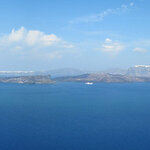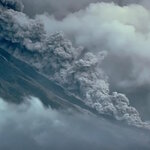Geology

A geophysicist has made the first-ever measurement of the strength of the magnetic field 1,800 miles underground - inside Earth's core.
The magnetic field strength is 25 Gauss, they say, 50 times stronger than the magnetic field at the surface that makes compass needles align north-south, the middle range of what geophysicists predicted, but it puts constraints on the identity of the heat sources in the core that keep the internal dynamo running to maintain this magnetic field.
A strong magnetic field inside the outer core means there is a lot of convection and thus a lot of heat being…

An asteroid the size of a Volvo exploded over Sudan's Nubian Desert in 2008 and initial research was focused on classifying the meteorite fragments soon after they were strewn across the desert and tracked by NASA's Near Earth Object astronomical network. Now in a series of 20 papers published in Meteoritics and Planetary Science and the diversity of these fragments introduces as many questions as it does answers.
In the first round of research, Carnegie Geophysical scientist Doug Rumble, in collaboration with Muawia Shaddad of the University of Khartoum, examined one fragment of the asteroid…

A little while ago, I had the pleasure of working on the Aegean island of Santorini. Santorini was the subject of my first blog post, and now I would like to go into a little more detail. I had meant to do it earlier, but recently I have been busy moving to another country...
The nice thing about Santorini is how accessible the geology is, both literally and figuratively. The impressive caldera cliffs and the lack of any real vegetation mean that much of the history of the volcano is exposed and with a little geological knowledge a lot can be learnt from those cliffs. …

Isn't dividing the world into disciplines the antithesis of Science 2.0? My preference would be no categories, but at the least, couldn't we have a Field called "Multidisciplinary" or "Science 2.0"?

Biogeochemists say new evidence linking glacial events during the "Snowball Earth" period to the rise of early animals.
The controversial Snowball Earth hypothesis, which originated in 1964 due to the discovery of glacial deposits near the equator, posits that on several occasions the Earth was covered from pole to pole by a thick sheet of ice lasting for millions of years. These glaciations, far more severe than the usual Ice Ages, occurred from 750 to 580 million years ago, and in their aftermath, the oceans were rich in phosphorus, a nutrient that controls the abundance of…

UPDATE: This was written before the 22 February earthquake, and I realise that recent events show my arguments may be a little too simplistic. My heart goes out to all thouse affected.
In hindsight, comparing Christchurch and L'Aquila to other earthquakes like Haiti and Sichuan would have better illustrated my point about building codes saving lives.
As my earlier post on the Christchurch and l'Aquila earthquake has generated far more hits and comments than any other, I felt I should revisit it here. The discussion has apparently even been picked up by a few local newspapers (…
In the Houston-Galveston Coastal Subsidence District, a group of researchers have found that a large section of northwestern Harris County, particularly the Jersey Village area, is sinking rapidly. They analyzed a decade's worth of GPS data measuring ground elevation in the Houston area and found that some points in Jersey Village are subsiding by up to 5.5 centimeters (about 2 inches) a year.
The group processed and analyzed GPS data from more than two dozen measurement points throughout the county, covering 1995 to 2005. Extrapolating data from six measurement stations, Shuhab…

Simple answer: Just don't be there in the first place.
I am currently on fieldwork on Santorini, which does involve a fair bit of walking from outcrop to outcrop. Walking past deposits from the last big eruption, the Minoan, I can't help but be impressed by the size of some of the chunks of rock the eruption transported. To pass the time, I have been playing a game of "what would I do if the volcano erupted now", thinking about pyroclastic flows and trying to work out where would be safest. So just a quick post until I get back and can write up the trip in some more detail.
Firstly I should…

We've all enjoyed the spectacular results when glaciers carved their way through the landscape and it seems intuitive that glaciers inhibit mountain growth due to erosion.
Not necessarily, say geologists, they can actually encourage mountain growth.
A new study in Nature found that glaciers in the southern reaches of the Patagonian Andes have acted as a kind of protective shield throughout that mountain range's 25-million-year history. As most people realize, glaciers erode mountains and slow their growth once the mountain peak reaches above the snowline. Above this elevation,…
With all the fuss surrounding whether the l'Aquila earthquake should have been predicted, the point is often missed that it didn't need to be. As the recent Christchurch earthquake has shown, a city can survive relatively unscathed without an accurate prediction. All it takes is proper preparation.
This is just a quick update to my earlier post on l'Aquila, as the recent Christchurch earthquake demonstrates a point that I didn't emphasise strongly enough there. The whole "prediction" aspect is a bit of a red herring, everybody knew that an earthquake was going to hit l'…